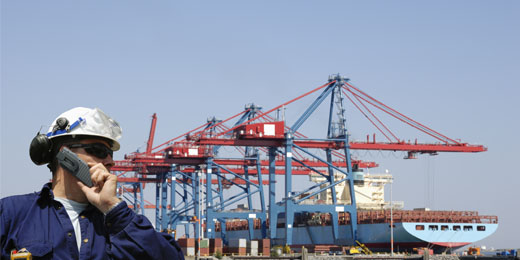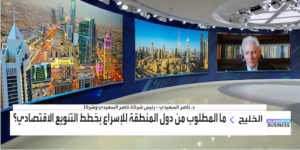Click to download the English & Arabic versions of the report. The Arabic translation is available on and provided by mostasmer.com
Markets
The global rally in equities continued last week, but at a much subdued pace (due to disappointing earnings reports) and wide performance range from the 4.30% surge in the Nikkei (after a +6.5% the previous week) to the -3.9% plunge of Shanghai which dragged several other emerging markets. Regional markets ended the week mostly higher, as oil prices held up and on a few positive earnings results. In currency markets, the yen took a dive as the hypothesis of negative rate loans is gaining credibility. Oil retreated from the intra-week 2016 highs but still recorded a weekly gain despite the disappointment of the inconclusive Doha meeting. Gold ended a positive week on the back foot.
Global Developments
US/Americas:
- US existing-home sales rebounded in Mar to a seasonally adjusted annual rate of 5.33 mn units from 5.07 mn in Feb, a 5.1% mom increase and 1.5% yoy. Separately, the NAHB Index of Builder Confidence remained unchanged at 58 in Apr.
- The Chicago Fed National Activity Index edged down to – 0.44 in Mar from – 0.38 in Feb, with three of the four index sub-components decreasing, indicating a sluggish end of Q1.
- The SEMI book-to-bill ratio gained 10 basis points in Mar reaching 1.15, the strongest reading since Aug 2010.
- Initial unemployment claims dropped 6,000 to 247,000 as seasonal adjustment issues depressed new filings. The 4-week moving average declined from 265,000 to 260,500.
Europe:
- The ECB kept interest rates steady, as widely expected, and left other stimulus programs untouched; Draghi defended the ECB’s independence and left the door open for further cuts.
- The latest euro area bank lending survey results showed that credit conditions remained eased in Q1 2016; the net percentage of banks reporting tighter credit for corporations was at -6% in Jan-Mar, following -4% in the previous quarter.
- Euro zone’s current account surplus narrowed to EUR 11.1bn in Feb, not seasonally adjusted, from a revised EUR 15.8bn a year earlier, largely due to the dramatic fall in oil prices and the depreciating euro.
- Investor confidence in Germany improved in Apr, with ZEW indicator of economic sentiment rising to 11.2 (Mar: 4.3) – though still below the historical average of 24.7.
- UK’s headline unemployment rate held steady at 5.1%, the lowest reading since mid-2008, in the Dec-Feb period. Unemployment meanwhile picked up by 21k to 1.7mn in the same period – the first increase since May-July last year.
- Retail sales in the UK rose 2.7% yoy in Mar, down from a revised 3.6% uptick in Feb.
- German producer price inflation fell 3.1% yoy in Mar (Feb: -3.0%), on weak economic activity and low oil prices.
- New-home prices in Germany rose 1.3% yoy in Mar, further to 1.9% gain a month ago.
Asia and Pacific:
- Japanese Industry Activity Index declined by -0.1 % mom in Feb after a brief gain of 1.5% mom in Jan.
- Japan’s trade balance recorded a surplus of JPY 276.5bn in Mar (Feb: JPY 166bn).
- Deflationary pressures persisted as wholesale price index in India fell for the 17th consecutive month, registering -0.9% yoy in Mar, unchanged from the rate in Feb. Price deflation, particularly in manufactured goods, confirms that the economy is operating under a negative output gap.
- India’s trade deficit narrowed to a five-year low of –USD 5.1bn in Mar, following a –USD 6.6bn reading in Feb. Exports fell 5.6% yoy while imports plunged by 21.6%.
- Taiwan’s retail sales grew 1.1% yoy in Mar (Feb: +0.1%), driven by stronger sales of automobiles, which had recorded a fall in Feb. In yoy terms, retail sales were down 3.3%.
- Industrial production in Taiwan declined -3.6% in Mar (Feb: -4.2%).
- Inflation in New Zealand picked up over Q1, rising 0.2% qoq (+0.4% yoy) after a -0.5% decline in Q4. Transport costs are down on lower oil prices, while higher tobacco prices contributed to the quarterly price increase.
Bottom line: The underpinnings for US growth, especially the job market, remain moderately positive, while in the other major economies, Euroland, China and Japan perspectives remain subdued. Laxer monetary policy and currency wars are unlikely to produce long lasting effects.
Regional Developments
- Non-oil GDP growth in Bahrain was up by 3.9% yoy last year while overall GDP grew by 2.9%. Construction, social and personal services (i.e. education and healthcare), hotels and restaurants supported growth in the non-oil sector. The oil sector share of real GDP fell to only 19.7% while shares of financial services and manufacturing were at 16% and 15% respectively.
- Net FDI in Egypt surged by 27% qoq to USD 1.718bn in Q2 of the financial year 2015-16; net inflows were USD 3.156bn in Q2 versus a reading of USD 2.9bn in the previous quarter.
- Egypt’s finance minister revealed that the country would delay its plans for an international bond issue while also stating that it had not yet begun talks for an IMF loan.
- Egypt’s non-oil exports rose 4% yoy to USD 1.9bn in Mar; EU states were the top importers of non-oil exports, with imports at USD 1.3bn.
- Iraq is planning to go ahead with its USD 2bn bond issuance, betting that aid over the next two years of around USD 15-16bn will lower its borrowing costs.
- Kuwait’s Parliamentary Financial and Economic Affairs Committee decided to exclude citizens residing in apartments or flats (provided they have no other private accommodations) from the proposed power/ water tariff hikes. Furthermore, both the agricultural and industrial sectors were also exempt from the hikes, given that the regulations for production sectors are to be decided by the ministry.
- Revised work permit and transfer fees were announced in Kuwait – to be effective June 1, these were increased substantially; charge for a work permit was raised to KWD 50 from KWD 2 currently and its renewal to KWD 10 from KWD 2, while transfer of the permit will be KWD 50 from KWD 10 before.
- FDI in Lebanon, which contributes about 6.7% of GDP, touched USD 3.2bn in 2015 (2014: USD 3.1bn), according to the chairman of the Investment Development Authority.
- Lebanon’s Ministry of Finance sold a USD 1.0bn dual tranche Treasury bond last week; it was around 128% subscribed.
- Total revenue of companies that are part of Oman’s MSM30 Index, including investment holding companies, reported an uptick of 7.3% yoy to OMR 958mn in Q1.
- Oman’s Producer Price Index-based inflation eased by 23.3% yoy in Q4 2015.
- Forging ties with Iran: the Port of Salalah signed a landmark MoU with Shahid Rajaee Port and Chabahar Port through the Port and Maritime Authority of Iran, in a bid to facilitate growth in shipping, trade and commerce for both nations.
- New construction contracts in Qatar, in Q1, fell to their lowest in five years: according to MEED data, about USD 830mn worth contracts were awarded in Q1 – this was down 92% yoy and 70% qoq.
- Saudi Arabia is set to reveal its “Vision for the Kingdom of Saudi Arabia” on Apr 25. The National Transformation Plan is part of the larger vision and will include reforms on asset sales, tax increases, spending cuts, changes to the way the state manages its financial reserves, an efficiency drive, and an increased role for the private sector. This is expected to be launched within 45 days of the announcement.
- Reuters reported that Saudi Arabia was close to securing the USD 10bn loan from banks (reportedly a group of US, European and Japanese banks) by the end of this month; this would be the country’s first foreign borrowing in more than a decade.
- Targeted cash handouts may be used to counter the impact of subsidy cuts on the lower- and middle-income citizens in Saudi Arabia, according to the deputy crown prince.
- Saudi Arabia’s Tadawul plans to establish an equity market for SMEs by 2017, for which it has received the support of the Capital Market Authority; this move will improve firms’ access to capital and encourage corporate governance.
- The Arab Monetary Fund estimates a consolidated budget deficit to the tune of 11.6% of GDP in the Arab region this year, compared to 11.5% last year and 2.8% of GDP in 2014. Public spending is projected to fall by 6% this year while tax reforms top the list of reforms aimed at fiscal sustainability.
- The GCC consulting market grew 9.4% yoy to USD 2.7bn last year, as per a report from Source Global Research; of this total, Saudi Arabia reportedly expanded 14.8% to USD 1.25bn while UAE, the second largest GCC consulting market, grew by 4.3% to USD 788mn.
- The GCC countries spend an average USD 2,000 per month per household on luxury items, according to a senior official of American Express Middle East. Qatar topped the list among the GCC countries, with an average spend of USD 4000. Holidays (32%), fine dining (31%) and personal wellness (17%) were top spend categories in terms of luxury experiences.
UAE Focus
- UAE has allocated the previously pledged USD 4bn to Egypt, with half of it investment and the remaining as an interest-bearing deposit at the central bank.
- The UAE central bank survey reported a rebound in demand for credit in Q1 this year; however, banks remained reluctant to provide business loans, “partially reflecting the negative impact of lower oil prices”.
- UAE became the first Arab country to ratify the World Trade Organisation’s Trade Facilitation Agreement; this contains provisions for expediting the movement, release and clearance of goods, including goods in transit.
- Inflation in Dubai was up 0.3% mom and 1.5% yoy in Mar, in spite of the 9.2% yoy drop in transport prices, as food prices and housing and utility costs grew 3.5% and 4.1% respectively.
- Remittances from the UAE through the money transfer operator Xpress Money was around USD 29.5bn last year, according to the COO. He also revealed that this was a quarter of the remittances from the region, which grew 9% yoy to USD 110bn.
Media Review
Cheap Oil’s Silver Lining for the Gulf
https://www.project-syndicate.org/commentary/oil-price-decline-opportunity-for-economic-reform-by-nasser-saidi-2016-04
Global SWF assets increase: Preqin
http://www.zawya.com/story/Global_SWF_assets_rise_to_651_trn-TR20160419nL5N17M4CPX2/
An overview on fixed income
http://www.advisorperspectives.com/commentaries/20160422-franklin-templeton-investments-global-economic-perspective-april
A chain reaction scenario in China
http://www.bloomberg.com/news/articles/2016-04-19/china-default-chain-reaction-looms-as-bills-take-192-days-to-pay
Saudi Arabia’s New Economic Era
http://www.thenational.ae/business/economy/how-saudi-arabia-is-planning-a-new-economic-era
http://www.thenational.ae/business/economy/consultants-flock-to-saudi-arabia-for-mother-of-all-transformation-projects
Iran: over-promised land?
http://www.economist.com/news/business/21697276-it-proving-harder-expected-investors-make-start-over-promised-land
A bright future for Solar Power in the Middle East
https://www.stratfor.com/analysis/bright-future-solar-power-middle-east
The Saudi financial hub attracts few institutions
http://www.bloomberg.com/news/articles/2016-04-19/saudi-10-billion-financial-district-missing-one-thing-banks
Powered by:







